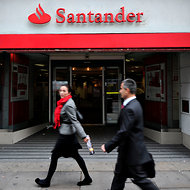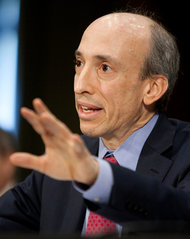 Carl Court/Agence France-Presse — Getty ImagesA Banco Santander branch in London.
Carl Court/Agence France-Presse — Getty ImagesA Banco Santander branch in London.
Banco Santander of Spain, the bank with the largest market value in the euro zone, said on Monday that its core capital ratio now stood at 9 percent, six months ahead of the deadline set by Europe’s main bank regulator.
Last year, the European Banking Authority ordered Santander to raise 15 billion euros in capital, the most of any bank in the European Union. The bank said it had met the ratio largely by converting 6.8 billion euros of bonds into shares, retaining profits and transferring a 4.4 percent position in its Brazilian unit to an outside investor, thus allowing the stake to be counted as core capital.
“This shows we have plenty of financial flexibility,” said José Antonio Alvarez, the chief financial officer of Santander. “Spain is in recession, but our balance sheet and capital base are in a better situation” than those of competitors.
Still, like all large European banks, Santander has been feeling the effects of the sovereign debt crisis and a very stingy funding market. But the bank is less exposed to its stagnating home market because it has a large presence in Latin America and Britain.
Santander’s quick move to reach the capital reserve requirement for European lenders was aimed at differentiating the bank from its more troubled peers in France and Italy. As with other banks, Santander has also been selling assets and cutting back on loans in order to preserve capital.
In a statement released on Monday, Santander said it planned to increase its capital ratio to 10 percent by June. The bank also said it would maintain its yearly dividend at 60 euro cents a share for a third consecutive year.
Article source: http://feeds.nytimes.com/click.phdo?i=a1e5981e500ef38bb53fd08a565d4bd9
